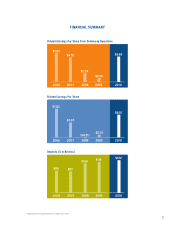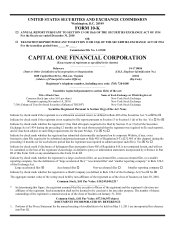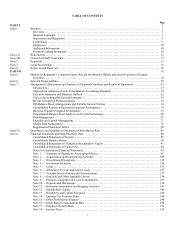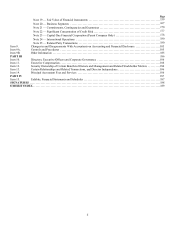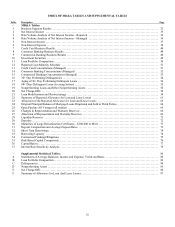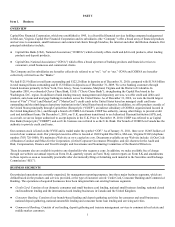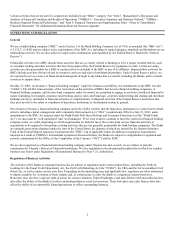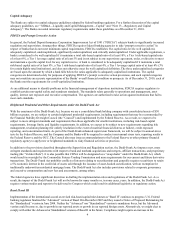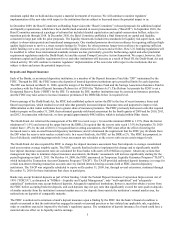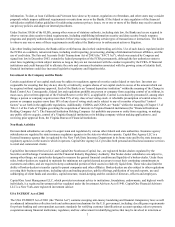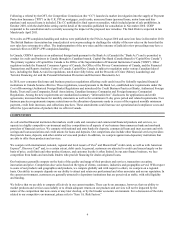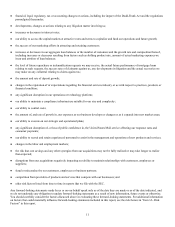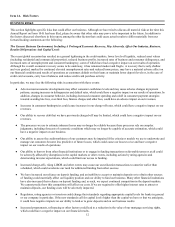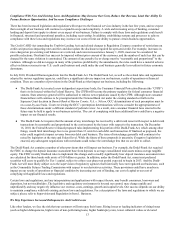Capital One 2010 Annual Report Download - page 23
Download and view the complete annual report
Please find page 23 of the 2010 Capital One annual report below. You can navigate through the pages in the report by either clicking on the pages listed below, or by using the keyword search tool below to find specific information within the annual report.3
New Regulations of Consumer Lending Activities
The Credit CARD Act (amending the Truth-In-Lending Act) enacted in May 2009, and related changes to Regulation Z, impose a
number of restrictions on credit card practices impacting rates and fees and update the disclosures required for open-end credit. For
example, increases in rates charged on pre-existing card balances are restricted, and rates increased since January 1, 2009, must now
be considered for possible reductions. Overlimit fees may not be imposed without prior consent, and the number of such fees that can
be charged for the same violation is constrained. The amount of any penalty fee or charge must be “reasonable and proportional” to
the violation. Payments above the minimum payment must be allocated first to balances with the highest interest rate. The amount of
fees charged to credit card accounts with lower credit lines is limited. A consumer’s ability to pay must be taken into account before
issuing credit or increasing credit limits.
State Consumer Financial Laws
The Dodd-Frank Act created a new independent supervisory body, the Consumer Financial Protection Bureau (the “CFPB”) that will
become the primary regulator for federal consumer financial statutes. State attorneys general will be authorized to enforce new
regulations issued by the CFPB. State consumer financial laws will continue to be preempted under the National Bank Act under the
existing standard set forth in the Supreme Court decision in Barnett Bank of Marion County, N.A. v. Nelson, which preempts any state
law that significantly interferes with or impairs banking powers. OCC determinations of such preemption, however, must be on a case-
by-case basis, and courts reviewing the OCC’s preemption determinations will now consider the appropriateness of those
determinations under a different standard of judicial review. As a result, state consumer financial laws enacted in the future may be
held to apply to our business activities.
Mortgage Lending
The Dodd-Frank Act prescribes additional disclosure requirements and substantive limitations on our mortgage lending activities.
Most of these provisions require the issuance of regulations by the CFPB or other federal agencies before they become effective.
Though we do not expect the resulting regulations to have a material impact on our operations, one new requirement under the Dodd-
Frank Act, the requirement for mortgage loan securitizers to retain a portion of the economic risk associated with certain mortgage
loans, could impact the type and amount of mortgage loans we offer, depending on the final regulations.
Debit Interchange Fees
The Dodd-Frank Act requires that the amount of any interchange fee received by a debit card issuer with respect to debit card
transactions be reasonable and proportional to the cost incurred by the issuer with respect to the transaction. On December 16, 2010,
the Federal Reserve released proposed rules implementing this portion of the Dodd-Frank Act, which among other things, would limit
interchange fees to no greater than 12 cents for each debit card transaction. The proposal was open for public comment through
February 22, 2011, with final rules to be effective on July 21, 2011. If finalized as proposed, the rules could negatively impact revenue
from our debit card business.
Dividends, Stock Repurchases and Transfers of Funds
Pursuant to Revised Temporary Addendum to SR Letter 09-4, dated November 17, 2010, we, like all large financial institutions
subject to the Supervisory Capital Assessment Program (“SCAP BHCs”), must consult with the Federal Reserve in advance of taking
any action that could result in a decreased capital base, including increasing dividends, implementing a common stock repurchase
program, or repurchasing capital instruments (“planned capital actions”). As part of that evaluation, the Federal Reserve, in
consultation with primary federal bank regulators, will assess capital adequacy of a SCAP BHC and any planned capital actions based
on a review of a comprehensive capital plan submitted by the SCAP BHC. Among other things, the capital plan must incorporate a
stress testing framework that considers a range and variety of economic, financial market, and operational events to estimate potential
capital needs.
Traditionally, dividends to us from our direct and indirect subsidiaries have represented a major source of funds for us to pay
dividends on our stock, make payments on corporate debt securities and meet our other obligations. There are various federal and state
law limitations on the extent to which the Banks can finance or otherwise supply funds to us through dividends and loans. These
limitations include minimum regulatory capital requirements, federal and state banking law requirements concerning the payment of
dividends out of net profits or surplus, Sections 23A and 23B of the Federal Reserve Act and Regulation W governing transactions
between an insured depository institution and its affiliates, as well as general federal and state regulatory oversight to prevent unsafe
or unsound practices. In general, federal and applicable state banking laws prohibit, without first obtaining regulatory approval,
insured depository institutions, such as the Banks, from making dividend distributions if such distributions are not paid out of
available earnings or would cause the institution to fail to meet applicable capital adequacy standards. However, we expect that we
may receive a material amount of our funding in the form of dividends from our direct and indirect subsidiaries.


